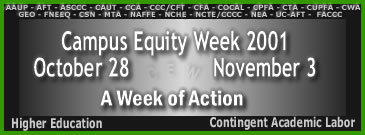|
CEW
PLANS
San
Jose State University - San Jose, California
The San Jose
State AFT local will be running a "favorite lecturer"
essay contest and we will be running ads in the campus paper on
Tuesday and Wednesday of Equity Week with quotes. Also we are planning
a wall of shame or wailing wall with lecturers' stories about life
in the fast lane.
Remember
that our rallying cry is to be ACADEMIC FREEDOM, which is the cornerstone
of higher education. Without academic freedom faculty cannot correctly
practice his or her craft or create/expand/disseminate an academic
knowledge base.
The
Following is a basic list of Facts to be used in CEW outreach. While
some are specific to San Jose Stae and the CSU system, many have
general application. They
will be revised and condensed into a flyer for CEW distribution.
WHAT IS HAPPENING ON CAMPUS IS TYPICAL OF WHAT HAS ALREADY HAPPENED
IN HIGHER EDUCATION IN MOST COLLEGES AND UNIVERSITIES ACROSS THE
COUNTRY.
CALIFORNIA HIGHER EDUCATION IS ACTUALLY BETTER OFF IN HOW ITS LECTURERS
ARE TREATED THAN OTHER PARTS OF THE COUNTRY.
Only
a few elite institutions are exempt. Ergo, moving to some other
state won't help if you stay a lecturer. Any they probably won't
have a TT job waiting for you as an alternative. [ Okay, housing
costs are cheaper than the Bay Area, but lecturer salaries are often
less than $2000 a course elsewhere.]
50% of campus faculty are lecturers. We have 1000 lecturers at SJSU.
30% of total instruction is done by lecturers.
67% of GED instruction is done by lecturers, according to a recent
memo from administration.
Only a minority, maybe a fourth of lecturers are long-term. This
is
due to a lot of reasons. One minor reason is that they are no longer
needed because they fill in for tenured colleagues on leave. This
is the reason administration likes to trot out. It is the flexibility
argument. The other is that they teach a specialized course for
which there is only an intermittent need, or a trendy interest of
the day.
Most lecturers teach because there are a lot of students that need
to be taught, on an ongoing basis, a basic and recurring range of
academic courses and programs. In other words,
THERE IS PLENTY OF WORK BUT NO JOBS!
More common reason why SJSU employs so many lecturers:
They cost much less money and can be fired almost at will.
Recently hired lecturers cost less money than longtime lecturers.
Only lecturers who teach 50% or three classes [as a rule] per
semester get benefits.
Very few lecturers ever get hired to TT positions if they become
available in the department. If hired, experienced lecturers get
almost no credit in terms of higher salary for years already taught.
Thus a long-term lecturer will very likely face a pay cut in the
unlikely event that (s)he does get selected for a TT position. I
believe the percentage of internal hires is less than 25% but it
may be less. I will check this.
Although there is one salary scale for all faculty, based on
professional competence and degrees, there is a low to high range.
Lecturers tend to get hired very low on their scale. They don't
know enough to negotiate a higher level on the scale when first
hired. Once there they move up through steps. These SSI's were taken
away during most of the 1990's and replaced by "merit-based"
PSSI's. Almost no lecturers got them for three years. Hence lower
wages.
Lecturers must teach five classes to get 100% of their salary. They
are not supposed to do any student advising, committee or other
administrative work. The theory is that TT faculty teach four classes
to get 100% of their salary plus they use the remaining 20% of their
time to do this administrative work. Whatever administrative work
lecturers may do, especially in advising students, doing BOGS assessment,
and serving on department committees, is considered voluntary and
outside the lecturer's job description.
At SJSU the cost of living drives a lot of lecturers and recent
TT
hires away after a short time.
Lecturers do get salary increases if they stay. However, the
departments do not. All lecturer funds to departments are lump sum,
based on number of extra students that the department taught LAST
YEAR beyond what the TT faculty was supposed to teach. That extra
money is based on an average lecturer wage pegged to a Master's
Degree. Departments with lots of PhD lecturers who have been there
a long time and which may have declining or static student enrollments
[or only this year increasing enrollments, as in poli-sci] are working
in the red and must get money from other operating areas to make
up the difference. One way to justify this overdraft is to place
lecturers in huge classes, like GED, where they can become cost-effective.
Department chairs and Deans are under great pressure to either hire
in lower cost lecturers, deny FMI's, range elevations, or at the
very least, not keep track of eligibility for SSI's, which lecturers
are supposed to get every 24 units taught.
Administration also wants low end lecturers, who at less than 50%
teaching load, are paid no benefits and if they rotate out after
a few semesters get no SSI's.. Because of our high cost of living
SJSU has had the highest decline of tenured faculty of all 22 campuses.
While the statewide figures are that ONE new faculty position was
created for 35,000 new students in the entire 22 campus system since
1994, at SJSU our thousands of new students lost 18% of our permanent
faculty since 1994. In their place came lecturer instructors. While
in some departments like ours the lecturer climate is good, in other
departments like LLD it is a nightmare. Since they are mainly Masters
teaching English to non-English speaking, the administration treats
them like they are unskilled teen-agers. Course wages are very low
and they recently hired in all new 23 year-olds fresh out of school
to exploit. Worse, in secondary education the trend at other campuses
(I am not sure about here) is to hire in grad students to teach
undergrads as "part of their job training", pay them next
to
nothing, keep them out of the union, and have them teach three and
four classes under "supervision".
At SJSU the main growth is in "job training" disciplines
like computers and business. Here they cannot get permanent faculty
because they offer much less than the private sector. Yet here the
overall pay is higher for all faculty than in less glamorous disciplines
like humanities, languages and arts. Lecturers also are regularly
denied grants and department development money for conferences.
Although the regulations entitle lecturers to lots of different
grants, the behind the scenes info is that grant committees in certain
colleges are ignoring lecturer proposals as a matter of policy.
[Info from a lecturer who spoke to a faculty member on such a committee,
summer 2001] THE MAIN PROBLEM FOR HIGHER EDUCATION WITH A LECTURER
WORKFORCE IS THAT LECTURERS LACK ACADEMIC FREEDOM. They may be hired
and fired at will.
No matter how long they are there, they are at the mercy of whatever
outside and inside political views and forces may be the trends
and power of the moment. The entire academic structure is built
on academic freedom: that is why we are supposed to have tenure
in the first place. [It was not designed for our job security but
to maintain the integrity of the academic process of knowledge gathering
and dissemination.] No matter how qualified lecturers may be, their
professional performance is always under threat by this lack of
tenure protection. In today'spolitical climate this lack of professional
protection is a looming problem for the entire edifice called higher
education.
Although lecturers are underpaid, so are TT faculty. Although
lecturers have too much work, so do TT faculty, only they do the
committee work and other service like chairing and senates and so
on. Everybody commutes and everybody keeps their discipline current.
Everyone has the academic expertise to teach their courses and direct
the process of higher education. Everybody gets hired, evaluated,
and retained based on ongoing assessment procedures. Some in both
camps do research/publish and some don't. These are common issues.
What is uncommon and must be hammered is the academic freedom issue.
THIS IS THE CORE OF THE LECTURER DISCUSSION. It honors our competence
and explains our neuroses much better than saying that we are underpaid,
harried and overworked.
Contact: Elena
|


